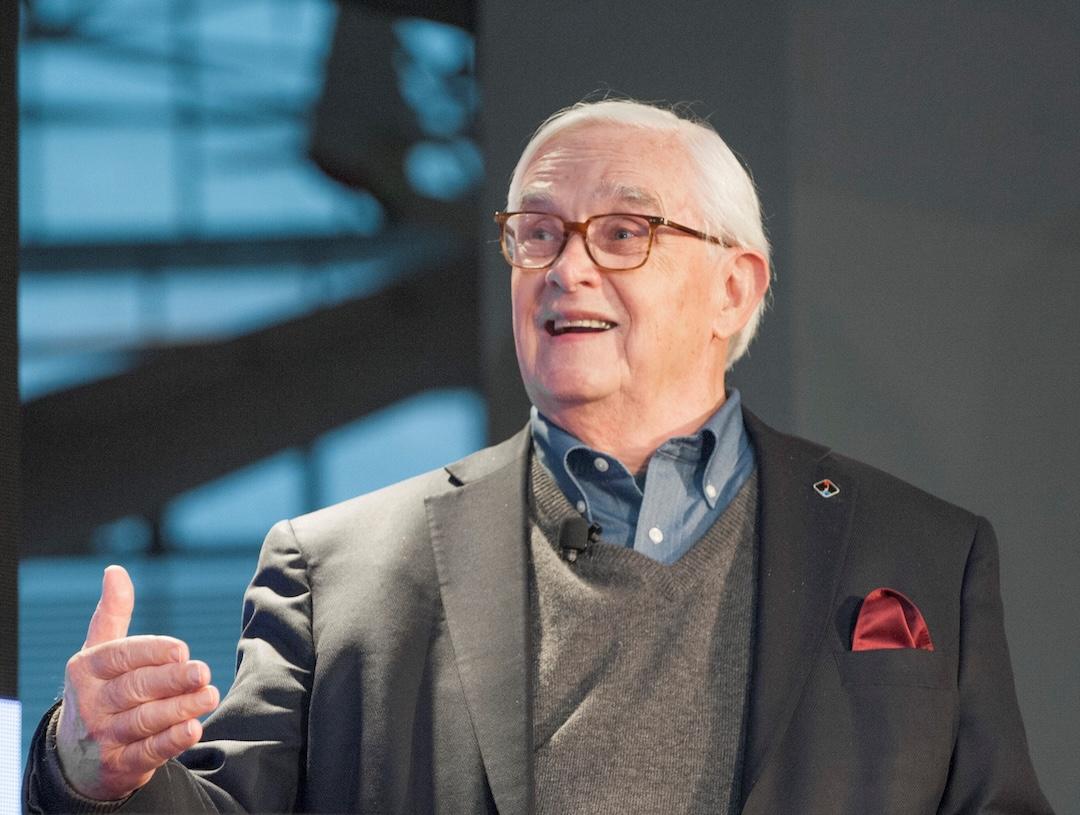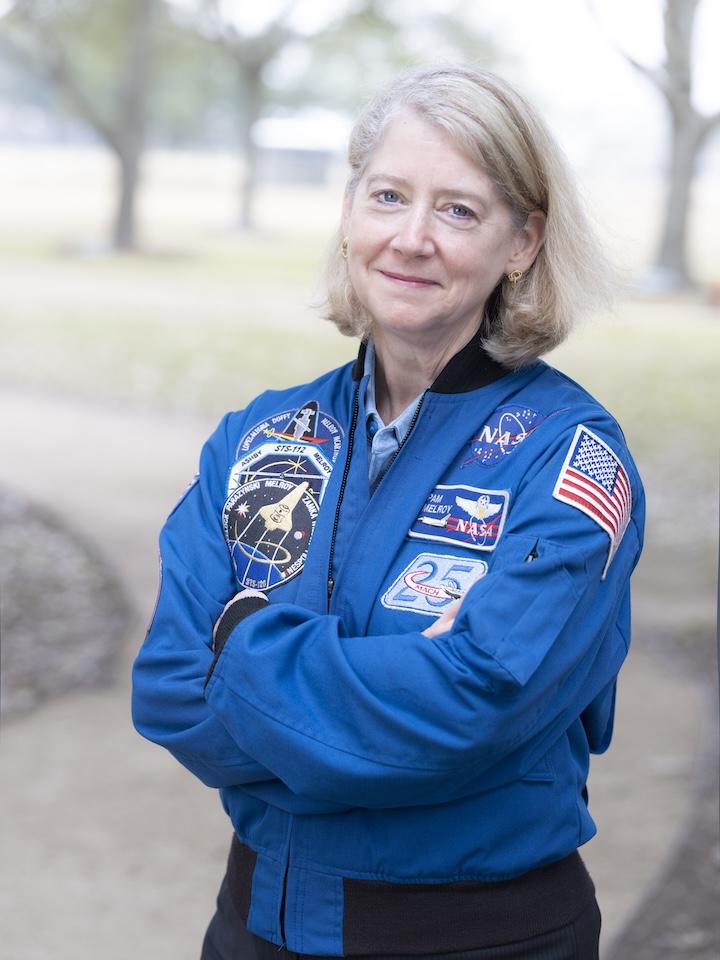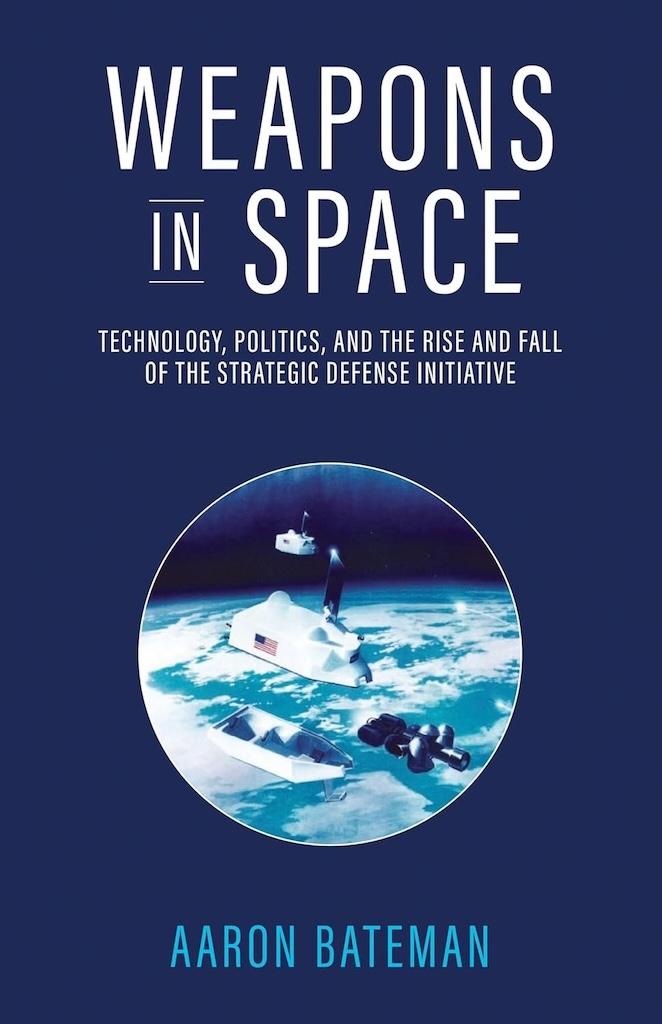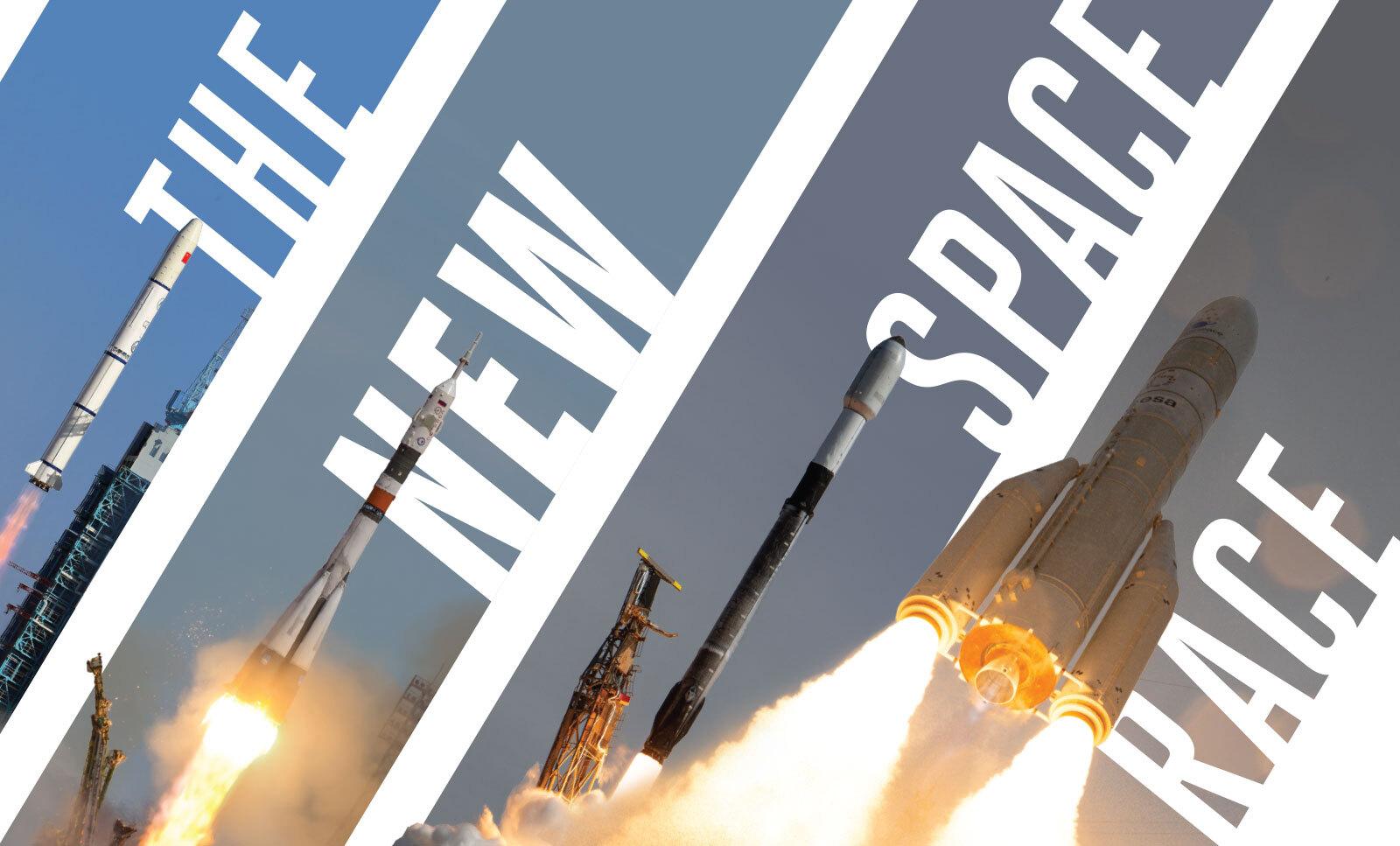The New Space Race
Space exploration has evolved from a two-nation race into a dynamic, global enterprise. In this new era, experts at GW’s Space Policy Institute are shaping the next generation of policymakers, industry leaders and scholars.
Story // Hannah Richter
In October 1957, the Soviet Union launched Sputnik, the first human-made object to breach the vast expanse of space. It supercharged the American space program, landing humans on the moon just over a decade later.
But once boots touched the powdery lunar surface, U.S. space progress was more like a “long, slow cook,” says Scott Pace, the director of the George Washington University’s Space Policy Institute (SPI).
At first, only the government had a significant role in America’s space activities, with NASA—a civilian agency—and the military designing and operating nearly everything from lunar landers and planetary probes to spy satellites. Then, the civil space industry took off in the ’60s and ’70s with the launch of commercial communications satellites and private companies manufacturing hardware for NASA and the national security community. Within a few decades, companies like SpaceX, Blue Origin and Virgin Galactic radically reimagined what commercial space could offer, with new pursuits like space tourism and reusable rockets.
As America found its space legs, so too did other countries. China, India, Canada, Japan and European nations developed into spacefarers with scientific, civil and military capabilities. Others, like the U.S.’s first space competitor, Russia, faltered due to political and financial instabilities.
Now space has “grown up,” says Henry Hertzfeld, a research professor of space policy and international affairs at SPI. “It's really not the same type of space race that we had in the 1960s.”
Today’s space-based systems have become essential to everyday civilian life. The more than 10,000 satellites in orbit overhead support everything from cell phone service and weather forecasting to the GPS in smartphones and cars.
Asking someone to imagine their life without space today is “almost like saying imagine your life without electricity,” says Deganit Paikowsky, an Israel-based nonresident scholar at the SPI who specializes in international relations, politics and national security around space. Preserving its free and fair use has made the geopolitics in the space domain more complex than ever.

“There got to be a lot of talk in the Washington space community about the need for an independent think tank on space issues. I woke up one morning and realized we were already doing that, and so [we] just put a new sign on the door.”
– John Logsdon
Founder and Former Director, Space Policy Institute
A Policy Pioneer
At the George Washington University, a small group of experts has spent nearly 40 years training generations of space leaders. Housed in GW’s Elliott School of International Affairs, SPI is a “bridge between pure academia and policy work,” says Pace, who has held leadership positions at NASA and the White House across three administrations.
“It’s our ambition to ensure that we are aware of, and ideally part of, any major movement in U.S. space policy,” he says. A primary goal is to get students and researchers to “think about governance and regimes that are very, very different from what we have here [on Earth].”
The institute was born out of GW’s Program of Policy Studies in Science and Technology, established in 1966 with NASA grants. Designed from its start with a policy focus, the university hired John Logsdon, an expert in space politics and policy, in 1968. By 1973, Logsdon was running space-related courses and research for a small group of master’s students. But it wasn’t until the 1986 Challenger disaster that an official Space Policy Institute took shape.
“There got to be a lot of talk in the Washington space community about the need for an independent think tank on space issues,” recalls Logsdon. “I woke up one morning and realized we were already doing that, and so [we] just put a new sign on the door.”
Today’s SPI operates with a few veteran experts, like Pace, Logsdon and Hertzfeld, plus around 10 other full-time, part-time and associated faculty. (Logsdon became a professor emeritus and retired as institute director in 2008 but still contributes to SPI's work.) It also welcomes short-term visiting and nonresident scholars from around the world with expertise across space politics and industry who conduct research, publish papers and lead seminars for students.
Few master’s degree programs offer space policy concentrations, enabling GW to carve out a niche. “The best place to study policy is where policy is made,” says Logsdon, who served on the Columbia Accident Investigation Board that examined the causes of the 2003 Columbia space shuttle disaster. “We are one of the very few places you could enroll and have the reasonable opportunity to rub shoulders with the people that are doing what you came to study.” The institute often invites such experts into classrooms and to join panels—from policymakers, to NASA administrators like Michael Griffin and Charles Bolden to international space agency leaders like Josef Aschbacher, the European Space Agency’s director general.

Scott Pace, SPI director, teaches classes at GW on topics such as space power and global affairs, and tools and scenarios in U.S. space policy.
SPI aims to prepare graduates to enter public service, industry and think tanks, rather than retain them in academia. With customizable courses and frontline research, the institute teaches students the languages of law, policy and economics in a nonpartisan environment—a good fit for individuals trying to switch or advance in their existing careers, says Pace. Some of its faculty also advise doctoral students pursuing dissertations on space politics, policy and engineering management.
The formula works well: SPI graduates have gone on to serve in leadership roles in government agencies, Congress, private companies and think tanks, from a deputy administrator at NASA to C-suite executives at SpaceX.
SPI is “a powerhouse in space policy,” says Bhavya Lal, Ph.D. ’12, former NASA associate administrator for technology, policy and strategy and an alumna of GW’s Trachtenberg School of Public Policy and Public Administration. “It’s a go-to place for serious discussions that actually move space policy forward.”
The New Space Economy
One of the most significant changes SPI has tracked in space is the shift from government monopoly to private sector engagement. A few decades ago, Earth’s economy only went “a few kilometers up—as far as an airplane,” says Lal.
But today there are more than 12,000 space-focused companies, more than half of which are American. In 2024, SpaceX launched into space 138 times—more than half of all worldwide launches, government or otherwise. And in March, Texas-based Firefly Aerospace became the first company in history to successfully land a private spacecraft on the moon.
Still, all this commercial activity was not the “big bang” it may seem, says Paikowsky. In fact, commercialization has been steadily growing for over 50 years and began as a solution to a financial pickle. As U.S.-U.S.S.R. tensions eased in the ’70s and ’80s, “the initial strategic incentives that ignited the whole space age decreased,” Paikowsky explains. The U.S. government had less Cold War cash to spend on space, yet satellites were increasingly important for civil functions like communications, Earth observation and navigation. “Kicking off a commercial environment was a solution to that question [of] how to use space in an affordable way,” she says. Regulation changes and government incentives then helped the space industry grow.
According to Lal, NASA has mostly moved “from owner to customer, consumer and partner” of space infrastructure. For example, in lieu of a government space shuttle, SpaceX has transported astronauts to the International Space Station (ISS) since 2020 in a sort of space taxi agreement. NASA also partners with industry to advance science through its Commercial Lunar Payload Services (CLPS) mission. Over the next few years, 14 private companies will attempt to deliver science instruments to the moon to study everything from lunar dust to radiation exposure to potential water sources. Firefly Aerospace’s lunar landing was the first CLPS success.
At the SPI, courses and research have evolved “from almost totally [about] government to government-private sector relationships” that reflect developments in the real world, says Logsdon.
The New Space Economy
$0
active satellites in orbit
(as of April 8, 2025)
$0
of today's satellites are designated commercial
$0
space-focused companies
Satellite Owner by Sector in 2025
Sources: Jonathan's Space Report and SpaceTech Analytics
There’s a wide range in how nations balance their government interests and commercial enterprises in space. Russia’s private space sector, for example, never flourished due to political barriers and funding challenges, says Pace. According to Lal, China’s commercial sector is “coming up fast” because of high levels of entrepreneurship and government and private investment. Japan and Europe are trying to grow their commercial space sectors, though they have access to far less venture capital and private equity funding than the United States and China, according to Pace and Lal.
The private sector is not a panacea, however. In the United States, there are a number of critical functions still spearheaded by NASA, particularly those that are especially advanced, risky or unlikely to have a business purpose, says Pam Melroy, an astronaut, former NASA deputy administrator and recurring guest of the SPI. For example, NASA’s aeronautics work includes engineering aircraft to avoid supersonic booms and developing planes that fly without human pilots. The government is also more advanced at forecasting weather and tracking space objects at scale to avoid collisions.
“If a nation is not good at space, they're going to be falling behind in all of their industries,” says Melroy.
On the military side, the U.S. Department of Defense spends more money on space than NASA does.

“If a nation is not good at space, they're going to be falling behind in all of their industries.”
– Pam Melroy
Astronaut and former NASA deputy administrator
“Any war we fight, we need space,” says Dean Cheng, a nonresident scholar at the SPI and an expert on China’s space program. While nuclear weapons in space are banned, and destroying or interfering with another nation’s satellites is internationally discouraged, high-resolution imaging satellites have been used in war since the 1990s to analyze terrain, find targets and track how adversaries are mobilizing. Communication satellites are vital for commanders and forces to relay information quickly across long distances, and navigation satellites like GPS ensure that vehicles, drones and missiles reach their intended destinations.
“There is a recognition that space is the ultimate strategic high ground,” says Cheng.
Much of modern space infrastructure is deemed “dual use,” meaning the same satellite can serve a combination of national security, civil and scientific purposes. For example, a satellite designed to help image natural resources on Earth may also share its data with military intelligence. On the one hand, this strategy uses satellites more efficiently. On the other hand, it muddles geopolitics, since even seemingly peaceful science efforts might have unseen military functions.
Friends and Foes
Humanity’s presence in space has always been political. Even President John F. Kennedy’s decision to send humans to the moon was not for exploration, but to make the United States look more powerful than the U.S.S.R. on the world stage, says Pace. Today, developing the most robust anti-missile capabilities, the most powerful rockets and the most fine-resolution remote sensing satellites are all geopolitical goals.
“There’s a very different pool of people who are using space today,” says Cheng. China, India, Japan, Canada and Europe, among others, have joined the United States and Russia in having developed national space programs. As more countries gain advanced space capabilities, there will also be more allies—and competitors—for the United States.
Smaller and newer spacefaring countries tend to focus on niches that will make themselves desirable partners for space powerhouses like the United States. For example, Paikowsky’s homeland of Israel has worked specifically on developing small and light satellites for Earth observation that could also be used for national security.
For more dominant space nations, being active in space is about “setting the agenda…the values, the rules [and] the identities,” says Paikowsky. Leading countries exercise soft power by setting the rubrics and etiquette of the game—for example, by stating their intentions to colonize Mars, developing capabilities to mine lunar resources or pledging to clean up space junk.
By nature of its financial and engineering requirements, space exploration fosters significant international collaboration. The ISS, a partnership between the United States, Russia, Japan, Canada and Europe, is the best-known example. The James Webb Space Telescope involved contributions from Canada and 12 European countries. The NASA-ISRO Synthetic Aperture Radar mission (NISAR), likely the most advanced and expensive Earth-observing radar satellite yet, is set to launch in 2025 as a collaboration between the United States’ and India’s national space agencies.
“Sometimes space people think we should cooperate in space, and it could prove we can cooperate on Earth,” says Pace. But “it’s the other way around—you cooperate with your friends.” Pace calls space a “lagging indicator of the state of geopolitics.”
No relationship better highlights that dynamic than the United States and China. In 2011, Congress passed the Wolf Amendment, a law that prohibits NASA from using federal funds to work directly with the Chinese government without specific congressional approval. Its reach often extends to forbidding Chinese nationals from attending NASA conferences or visiting NASA facilities.
While the amendment was intended to protect American intelligence and technology while taking an official stance against Chinese human rights violations, some experts believe it has propelled China toward an independent and increasingly successful space program. China has its own weather satellites, GPS equivalent, lunar sample returns and Mars rovers. Its permanently crewed space station, Tiangong, has the potential to foster powerful alliances with other spacefaring nations like Russia as the ISS nears retirement. China has also helped countries like Nigeria, Venezuela, Ethiopia and Pakistan launch satellites, and it boasts a growing commercial space sector.
There is a “general recognition that China is posing a greater and greater threat to America’s space preeminence,” says Cheng. China and the United States are eyeing two major goals: taking humans back to the moon and bringing home Mars rocks. Though scientists are eager to see rock samples from another planet, being the only country to put astronauts on the moon has been “a key part of American exceptionalism,” says Cheng. “When the first Chinese astronaut bounces on the lunar surface and plants that five-star flag, that moment of American uniqueness ends.”
SPI research, classes and symposiums highlight the cruciality of well-considered international space policy. While the United States cannot control other nations’ advances, it can make strategic partnerships to further shared goals, like having a larger human presence on the moon. Logsdon and Melroy point to the Antarctic Treaty—which designates the continent a peaceful zone to foster scientific cooperation—as a model that could be replicated in space.
“When the first Chinese astronaut bounces on the lunar surface and plants that five-star flag, that moment of American uniqueness ends.”
– Dean Cheng, SPI scholar
To show leadership, the United States must prioritize convening other nations, says Melroy. In 2020, NASA created the Artemis Accords, in which 53 nations to date have pledged to limit orbital debris, share science data and regulate lunar resource extraction. While China and Russia are not signatories, the Accords help demonstrate strength through numbers and guarantee the United States a seat at the table in space negotiations.
“For years, U.S. philosophy [about space] collaboration was ‘my way or the highway,’” says Paikowsky. With the Artemis Accords, she says, the United States acknowledges that leading the modern space era requires allies and cooperation, not just expert engineering or national strength.
Today, “great powers don’t…race each other” in space, she says. “They compete for the attention and support of the international community.”
Staying ahead of the curve
SPI is well-equipped at “making sense of a fast-changing space world,” says Lal. No matter the future, the institute will “help make sure space policy keeps up.”
SPI frequently hosts panels, book discussions and symposiums on topics from artificial intelligence in space to China’s space development. SPI scholars also publish academic papers, resources aimed at government officials, and popular articles and books to explain the history of space to the general public and inform current conversations. For example, Logsdon edited seven volumes of documents on the history and evolution of U.S. involvement in space, while Cheng recently published a book, “China and the New Moon Race,” on the country’s lunar ambitions.
Another key role of SPI experts is to engage in domestic and international policy discussions. Pace and Hertzfeld have both provided congressional testimony, including before the Senate Appropriations Committee on Defense and the House Subcommittee on Space and Aeronautics. Pace also participates in annual meetings of the UN Committee on Peaceful Uses of Outer Space, and he has crafted national space policy on GPS, human space exploration and cybersecurity during his years in government.

Pace (left) testifies before the House Subcommittee on Space and Aeronautics about the Artemis Program and NASA’s path to human exploration of the Moon, Mars and beyond in March 2025.

Hertzfeld has testified before the House Subcommittee on Space and Aeronautics on commercial space policy, as well as presented to the United Nations Committee on the Peaceful Uses of Outer Space.
SPI will also continue to teach students and advise policymakers on developing a space economy that preserves national interests, such as whether nations should mine the moon or asteroids for resources such as metals and water, or build space-based depots for propellant—in essence, space gas stations—to extend the life of spacecraft, Lal says.
On the national security side, Cheng is keeping an eye on lowered launch costs thanks to contributions from commercial companies that may render a space-based missile defense system feasible in the near future—a prospect he says would have bankrupted the government 40 years ago.
But while industry plays a large role in shaping the U.S. space economy and military, the government, its largest customer, ultimately gets to direct its priorities and regulation. “There’s a growing realization that rules are needed,” says Logsdon, and the SPI is training students to write them.
Amid all their research and policy priorities, one of the SPI’s key tasks is explaining the significance of America’s space future to everyone, not just policymakers. “The problem that we've always had,” says Hertzfeld, “is that space is one step removed from our routine use; it's abstract.” Though space plays a larger role in our economy and geopolitics than ever before, it’s largely hidden miles above our heads.
Space is “not so much about flags and boots anymore, although that is certainly a piece of it,” says Melroy. Advancing science, growing public services, preserving national security and inspiring the next generation of scientists and engineers are all direct returns from strong space policy, she says. At the end of the day, “it’s really important to understand that we go to space to benefit life on Earth.”
Photos by William Atkins and the GW Space Policy Institute



Books published by Space Policy Institute Scholars Aaron Bateman, Dean Cheng and John Logsdon.

